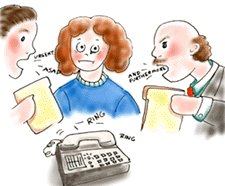Compromised Attention After Concussion – Quantifying Attention Deficit
Understanding Compromised Attention After Concussion
By Gordon Johnson
Call me at 800-992-9447
Compromised attention after concussion is most easily understood if we compare it to the RAM on a computer. A couple of pages back, I asked the user to think of the brain as having a fixed RAM capacity, similar to that of the laptop I am writing this web page on. This MacBook Pro has 16 gigabytes of RAM. While the brain has far greater capacity to retain data in its immediate state than a laptop computer, I used the 16 gigabytes example to help illustrate how attentional demands get allocated and consumed in the brain.

Compromised attention after brain injury is the unitary problem that links almost all other deficits.
In previous pages, we have talked about the normal demands of cognitive tasks, such as conversation. We have also talked about the increased attentional demands of anxiety and depression. We spent further time on discussing the compromised attention after concussion of a malfunctioning vestibular system. Lastly, we talked about pain as an attention grabber. Every deficit after a concussion can result in compromised attention after a concussion. But these four deficits of anxiety, depression, vestibular dysfunction and pain are the most obvious.
We started our analogy by assuming that conversation would take 4 gigs of the brain’s 16 gigs of RAM. If the brain is anxious this could require another 4 gigs. Depression might consume another 2, but if depression and anxiety are working together, then the cumulative impact of these could be as high as 8. Thus, with just three areas of dysfunction, the brain’s ability to keep up in real time, could be getting close to compromised.
Now add to that attentional stress a dysfuntion in the vestibular system. As the vestibular system requires visual processing, it needs more attention to translate bad input. A dizzy or vertigo suffering patient, may need almost all of the hypothetical 16 gigs of RAM, just to stay standing. Driving in a car may be even worse because of the speed at which the world goes by.
Then there is the wild card of pain. A little pain might be lost in the background, but the more pain, the more it distracts. Escalate the pain to migrainal levels, and it may consume attention. Again within our hypothetical allocation of the brain’s 16 gigabytes of RAM, pain ends up taking something tangible at the chronic level and increasingly larger chunks as it increases in intensity.
A key issue in understanding compromised attention after concussion is that all four of these specific challenges have the potential to interact synergistically with each other. Pain increases anxiety. Pain gives the brain injury survivor more to be depressed about. The sensations of vertigo can be caused or exacerbated my migraines. For each of these major issues, there is an interplay with one of the other major items, to wreak havoc on attention.
So what happens to the mind when it exceeds its upper limits of RAM demand? I titled this endeavor which is now part of BrainInjuryHelp.com “Crashing Minds.” Does the brain literally crash? Not really. But the brain’s ability to deal with the real world, to control behavior, to make decisions, to remember, to not become overwhelmed – yes those things crash. Compromised attention after concussion is the single biggest factor that interferes with a good and lasting recovery.



